Hub loads of an articulated helicopter rotor in hovering: a multidisciplinary approach
Università La Sapienza di Roma
One of the most challenging problem associated with helicopters is the cabin internal noise. A source of this noise can be the vibroacoustic excitation of the fuselage associated with the loads transmitted by the main rotor, which induce vibrations at low frequencies of the audible sound band. These loads derive from the aeroelastic response of the main rotor, that involves different multidisciplinary issues, such as: the multibody dynamics for the mechanical chain required for blade control, the nonlinear analysis of structure for the elastic blade behaviour, the aeroelasticity of the blade for the aerodynamic load dependence on blade deformations, and the flight dynamics for the coupling between the helicopter’s flight condition and the main rotor aeroelastic problem.
To study the loads induced on the fuselage in hovering condition while considering all these disciplines, a MSC.Adams multibody model has been developed for an articulated rotor with five flexible blades attached to the hub with elastomeric bearings.
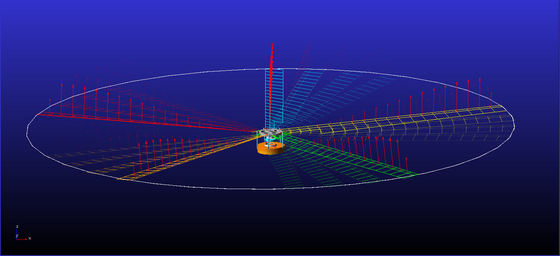
MSC Adams model of the main rotor.
Different level of fidelity has been considered for the various aspects involved.
The blades were modelled by joining different flexible bodies based on linear superposition method and small strain assumption, and their nonlinear kinematics was accounted by the large rigid body motion to which each flexible body is subjected during rotation. This approach allowed to have an efficient representation of blade behaviour in terms of computational time.

MSC Adams model for one flexible blade with nonlinear behaviour
The mechanical system required for blade control was realized with rigid bodies (Figure 3), that were so represented exactly. The control inputs were applied to the blades by controlling the orientation and vertical translation of the swashplate.
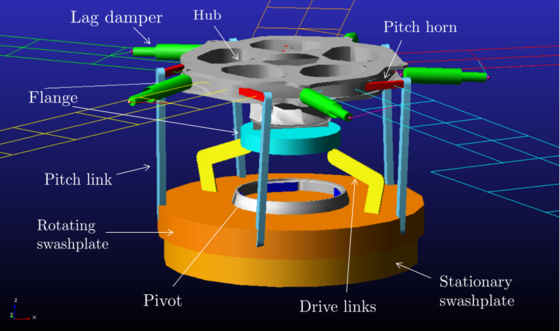
Mechanical system for blade inputs application
The aerodynamic loads were applied on the blades as three component force vectors (Figure 4) acting on the interface nodes between the flexible bodies, and a simplified aerodynamic model was used to take into account of blade deformations.
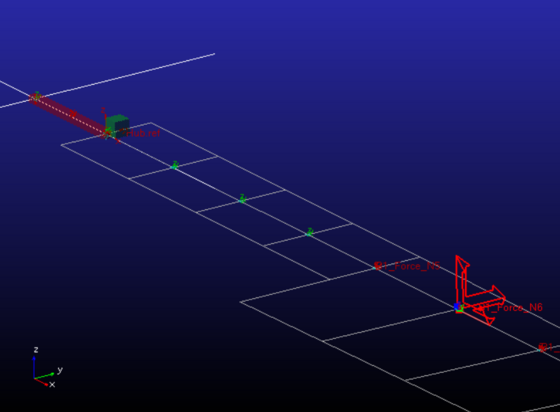
Aerodynamic loads application on the blade as three component force vectors
A preliminary aeroelastic trim procedure has been done in Matlab by performing several MSC.NASTRAN nonlinear analysis (SOL 400) in order to account of nonlinear blade kinematic and axial loading condition associated to the centrifugal force field. This design procedure had the aim of finding the structural and inertial characteristics of the blade together with the collective control angle required in hover, that would guarantee small deformations at the tip and low structural weight.
Two analysis has been carried out on the complete Adams model of the main rotor, by applying the collective and cyclic control inputs to the blades. It has been seen that the introduction of the mechanical system for blade control is fundamental for obtaining the correct loads acting on the fuselage (Figure 5), and for considering the coupling effects that it induces between the blade degrees-of-freedom. However, only in the case of cyclic pitch input the loads transferred to the fuselage have presented harmonics in the audible sound band that can excite the vibroacoustic problem of the fuselage (Figure 6).
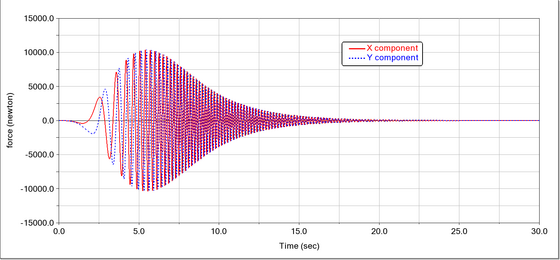
In plane components of the force induced on the fuselage by the main rotor, due to the presence of the control chain
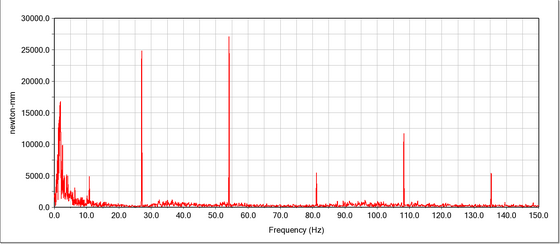
Harmonic content of the moment transmitted to the fuselage that opposes hub rotation
Author: Matteo Di Manno
Academic year: 2019/2020